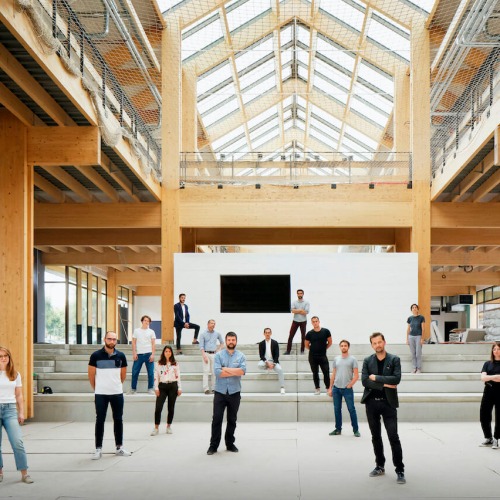Image

Author:
Samuel Poutoux, Rémi Crozat, Marc-Henri Maxit, Julien Déchanet. Atelier WOA
Atelier WOA
The mastery of the architectural project requires the mastery of its manufacture. It is with this conviction that Samuel Poutoux and Rémi Crozat, architects, joined forces in 2012 with Marc-Henri Maxit, economist and carpenter contractor, to create a resolutely multidisciplinary structure called WOA, acronym for Wood Oriented Architecture.
Of the three partners, two already have had solid experience in wood framing and timber construction. Samuel Poutoux developed a concept of wooden office built by Real estate developer Nexity and, at a time when this technology was still not widely used in France, Marc-Henri Maxit had initiated many projects in solid wood panels (CLT).
Nonetheless, the associates quickly turned to mixed construction systems, where wood no longer has an exclusive place even if it continues to play a central role. For WOA, constructive rationality guides the use of materials according to the contexts, programs or requests of clients or contracting authorities.
The agency's approach is characterized by the desire to solve spatial and construction problems, and by the confidence that materiality generates architecture. The control of all construction issues also allows the control of construction costs. WOA's experience in this area has demonstrated the soundness and relevance of its proposals.
If ecology is an intrinsic component of WOA’s architecture, a bureau that has structured and developed around the wood material, its role is however not confined to that of skilled technicians: the mix of programs and structures, the interweaving of constructive and functional elements, the understanding of regulations as much as ecological concerns as well as spatial, financial or constructive constraints shape their architectural expression and vocabulary.
The partners, now four in number with the arrival of Julien Déchanet in 2019, adopt collective logics to respond to projects requiring a substantial agency size and WOA regularly joins forces with Vincent Lavergne’s office when subjects demand.
Of the three partners, two already have had solid experience in wood framing and timber construction. Samuel Poutoux developed a concept of wooden office built by Real estate developer Nexity and, at a time when this technology was still not widely used in France, Marc-Henri Maxit had initiated many projects in solid wood panels (CLT).
Nonetheless, the associates quickly turned to mixed construction systems, where wood no longer has an exclusive place even if it continues to play a central role. For WOA, constructive rationality guides the use of materials according to the contexts, programs or requests of clients or contracting authorities.
The agency's approach is characterized by the desire to solve spatial and construction problems, and by the confidence that materiality generates architecture. The control of all construction issues also allows the control of construction costs. WOA's experience in this area has demonstrated the soundness and relevance of its proposals.
If ecology is an intrinsic component of WOA’s architecture, a bureau that has structured and developed around the wood material, its role is however not confined to that of skilled technicians: the mix of programs and structures, the interweaving of constructive and functional elements, the understanding of regulations as much as ecological concerns as well as spatial, financial or constructive constraints shape their architectural expression and vocabulary.
The partners, now four in number with the arrival of Julien Déchanet in 2019, adopt collective logics to respond to projects requiring a substantial agency size and WOA regularly joins forces with Vincent Lavergne’s office when subjects demand.
+
-
-
NameSamuel Poutoux, Rémi Crozat, Marc-Henri Maxit, Julien Déchanet. Atelier WOA





